Kabul airborne operation
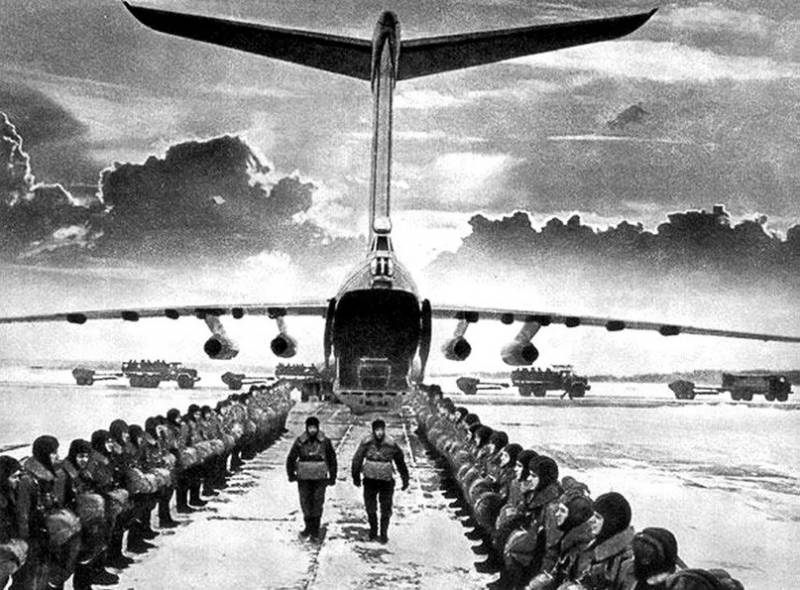
Home
One of the popular topics on the domestic Internet is whether the entire military air transport fleet would have enough forces to transport one airborne division. Thanks to the efforts of General Margelov, a unique vehicle was adopted into service with airborne units in the late 60s - an airborne combat vehicle. The main unique quality is the possibility of parachute landing of this vehicle. At this moment, the development of the USSR Airborne Forces took its own unique path.
Until now, no country in the world has a fully mechanized airborne force. There are not even simple trucks. During Operation Desert Storm 1991, the 2nd Brigade of the 82nd Airborne Division of the United States was “motorized” by National Guard motor companies. Indeed, transporting almost 500 BMD-based vehicles and 300 transport vehicles at a time is still a challenge.
And a textbook example of solving this problem is the Kabul landing operation.
103 Guards The airborne division was stationed in 2 settlements of Belarus: the 317th airborne division, the 1179th artillery regiment and divisional units in the city of Vitebsk, the 350th and 357th regiments in the village of Borovukha, 325 kilometers from Vitebsk. The parachute regiment had about 100 vehicles based on BMD and more than 100 transport vehicles: both airdropped Gaz-66 and non-landed "Urals", which were mainly part of the regimental transport and utility company (serving for transporting ammunition and fuel). In the artillery regiment: 18 D-85 cannons, 12 D-30 howitzers. All guns are towed.
Thus, the artillery regiment had about 100 transport vehicles. Plus a standard divisional set of units: reconnaissance company, anti-aircraft division, engineer battalion, communications battalion, medical battalion, rembat, transport company, SU-85 division (31 vehicles), rocket battery (6 BM-21V MLRS).
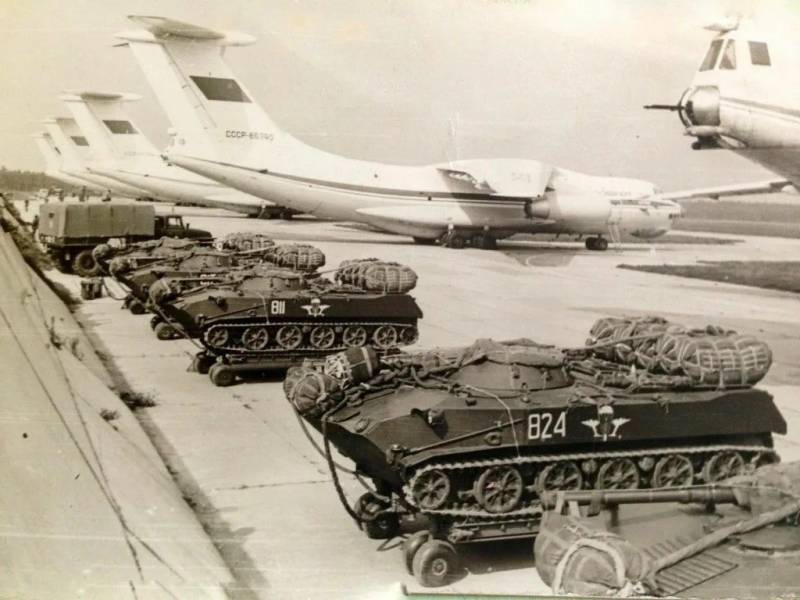
In total, the USSR Airborne Forces had 7 divisions, including one training division. The 105th Airborne Division was disbanded literally a couple of months before the events in question.
The division lived the ordinary life of the Soviet Army at the end of the 70s. They ran and jumped, shot and blew up. In the plans of the General Staff, the division was to be used in Western Europe. The chair of the division commander, General Ryabchneko, was a little wobbly due to the state of military discipline, but this is normal.
In the summer, the division, like the entire army, sent a virgin soil battalion (500 transport vehicles, 1 personnel) to grow potatoes. In the fall, the conscripts who had served their time were dismissed, and the division accepted new reinforcements, who had not yet taken the oath at the beginning of the events.
But at the same time, about 20 officers from division commander to battalion commanders visited Kabul back in September-November (three sources give three different times), where on-site reconnaissance of the future theater of operations took place. But this had no effect on the division’s preparations.
The Tselinny battalion was not recalled (the last train with equipment arrived on December 10), life flowed in a peaceful direction. On the one hand, it was necessary to maintain secrecy so that the information did not leak, but, on the other hand, perhaps the division could be better prepared for the upcoming war.
Anxiety
On December 10 at 23:00, the “Combat Alert” signal rang out in units of the 103rd Guards Airborne Division. According to the tradition of those years, all alarms were known in advance. However, according to the recollections of the participants, this time it was a sudden event. All night until the morning there was non-stop preparation for the march: the necessary things were packed for the journey, the vehicles were equipped, and the vehicles were refueled.
Parachute systems were filmed (some participants write that the PRS was filmed in parks, while others say that they were filmed right at the departure airfield). The companies were replenished with young recruits from quarantine. They took the oath on board the planes. Everything was so unusual and serious that there was no doubt that something extraordinary was brewing, something global.
By morning the division began moving to the loading airfields. Each of the division's regiments was divided into 2 airfield groups (an airfield group is an independent tactical unit of the Airborne Forces, capable of solving combat missions behind enemy lines autonomously. The division's parachute regiments, together with the artillery regiment, were divided into airfield groups, the basis of which were paratroopers battalions with attached means and means of reinforcement).
In the regiments of the first rush of the division (357 went first to Bagram, 350 to Kabul) advanced (assault) battalions were formed. Such a battalion was transported by Il-76 aircraft. The remaining forces of the regiment were transported by An-12 or An-22 propeller-driven vehicles.
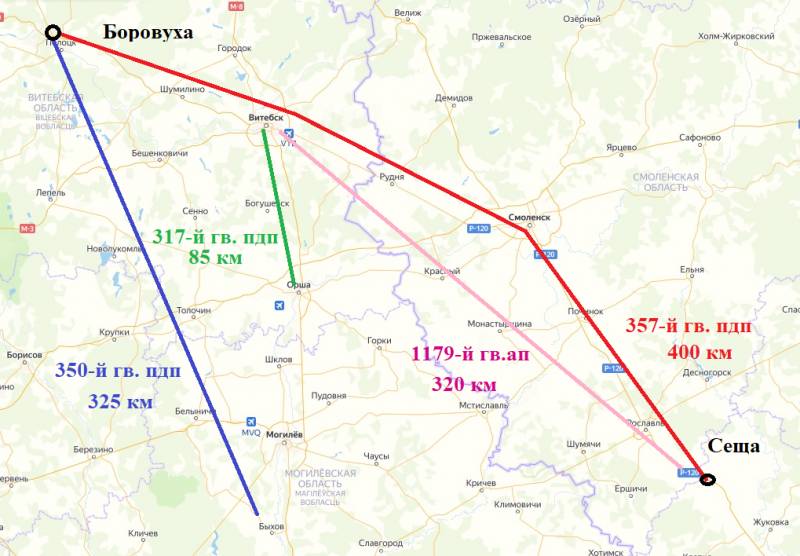
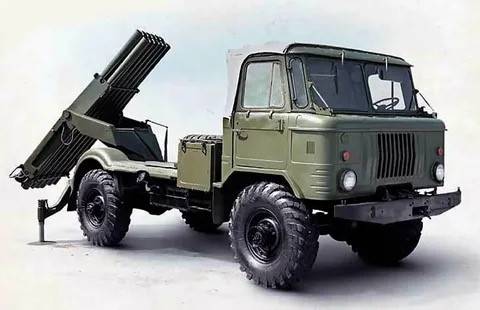
The 1st battalion of the 317th regiment was sent to Smolensk (apparently according to combat deployment plans). But the Smolensk airfield was under reconstruction at that time, and the battalion returned to Vitebsk. The 2nd battalion of the same regiment was concentrated in the “Warm Forest” near the Vitebsk-Severny airfield. The 3rd battalion with the rear of the regiment went to Orsha, Bolbasovo airfield (402 TBAP DA).
The 350th regiment was transferred by rail to Bykhov (airfield 57 MRAD).
Thus, in addition to the entire military transport aviation, the Ministry of Railways also had to concentrate in advance and submit for loading about 200 railway platforms (in the RDP there are 100 combat vehicles + 100 transport vehicles, a total of 200. 2 per platform - 100 platforms per regiment).
The 357th, also by rail, part of its forces arrived in Vitebsk (1st and 2nd battalions), and the other part (3rd battalion and combat support units) to the unique airfield (by its design) Seshcha (566 VTAP), 400 km from Borovukha. The artillery regiment went there under its own power.
It turned out interesting with a reactive battery. She was loaded onto planes in Vitebsk, but then unloaded, arrived under her own power in Seshcha and loaded again.
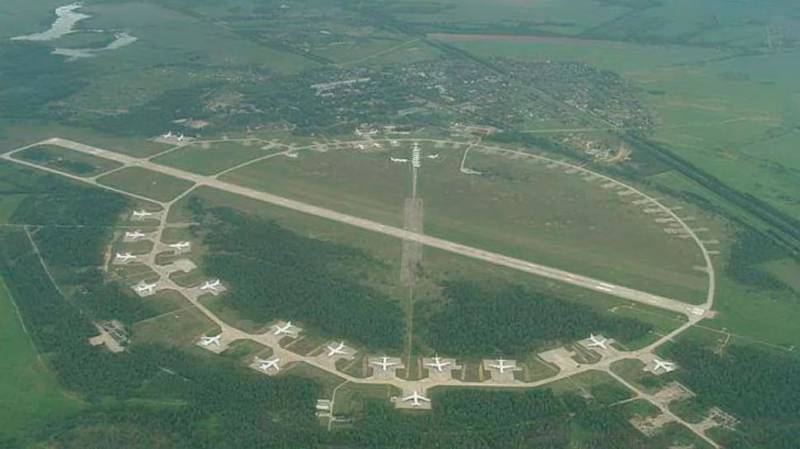
Divisional units (reconnaissance, anti-aircraft division, sappers, division's ZKP) also arrived at the Bolbasovo and Vitebsk airfields. Already in mid-December, the transfer of division command and special units began to the Balshakh airfield (39 ORAP). This transfer was mainly carried out by vehicles of the 3rd VTAD (110, 334 and 339 VTAP). There, some of the units were unloaded, and on the 357th the planes made another flight from Vitebsk - with units of the XNUMXth regiment.
Also in mid-December, the transfer of the 350th regiment to Central Asia began. On December 14, 26 AN-22 of the 12th regiment (8th and 81st regiments), having loaded 1 paratroopers and 300 units of military equipment at the Bykhov airfield, flew to the Tashkent airfield. But many heavy aircraft and paratroopers frolicking around attracted too much attention at the civilian airport, and two days later, on December 80, this group flew to Engels airfield (17 TBAP YES). According to other sources, 1230 aircraft took part in this transfer.
By the way, during the Zapad-81 exercises, 40 An-22 aircraft were enough to transport and land 119 airborne troops without a battalion and an artillery regiment unit. Then 76 units of equipment and 1 soldiers were landed. Although theoretically 560 aircraft are enough to lift 40 units of equipment. According to third data, 160 aircraft out of 52 available took part.
Most likely, 566 VTAP still remained at its home airfield for the transfer of 1179 AP and a self-propelled gun battalion and did not take part in the transportation of 350 airborne troops. By the way, the 566th VTAP, along with the 194th Fergana Regiment, had extensive experience with flights to Bagram. In November, he participated in the transfer of Musbat equipment, and in December - the 2nd battalion of the 345th regiment.
After the An-22 aircraft took off from the Bykhov airfield, Il-76 aircraft of the 18th Guards landed there. VTAD, namely 128 Guards. VTAP. Having loaded the 2nd battalion (assault) with 350 airborne troops on December 15, they flew to Chimkent. The remaining two regiments remained in place. The political leadership had already decided to send troops, but the deployment of units of the Turkestan district continued.
Flight to the initial landing area
In the last ten days of December, the remaining parts of the division began to move:
- On December 23, the 1st battalion 317 aircraft 930 VTAP from Zavitinsk flew from Vitebsk to Shadrinsk (Kurgan region) and further to Fergana. The route of the 2nd battalion lay through Kamen-Uralsk to Chirchik. Both battalions were transported by An-12 aircraft.
– On December 24, the 3rd battalion set off on a long journey from Bolbasovo on An-12 planes through Chelyabinsk to Leninabad (now Khujand, Tajikistan) and Samarkand.
– On December 24, the 1st and 2nd battalions of the 357th regiment flew from Vitebsk to Balkhash. The transfer was carried out by Il-76 of the 3rd VTAD. Balkhash became the initial landing area for the group flying to Bagram.
– The 3rd battalion of the 357th regiment was also loaded into an An-24 in Seshche on December 12 and flew to Fergana via Orsk.
– The artillery regiment and the MLRS battery took off on December 26 from Seshcha, and the SAU-85 division from Bykhovo to Engels. By that time, the planes with the 350th regiment had already left for Tashkent and Kabul.
Total of 9 combat battalions:
– 2 battalions (1/350 and 3/350) flew An-22;
– 3 battalions (2/350, 1/357 and 2/357) on Il-76;
– 4 battalions (3 of the 317th regiment and 3/357) on the An-12.
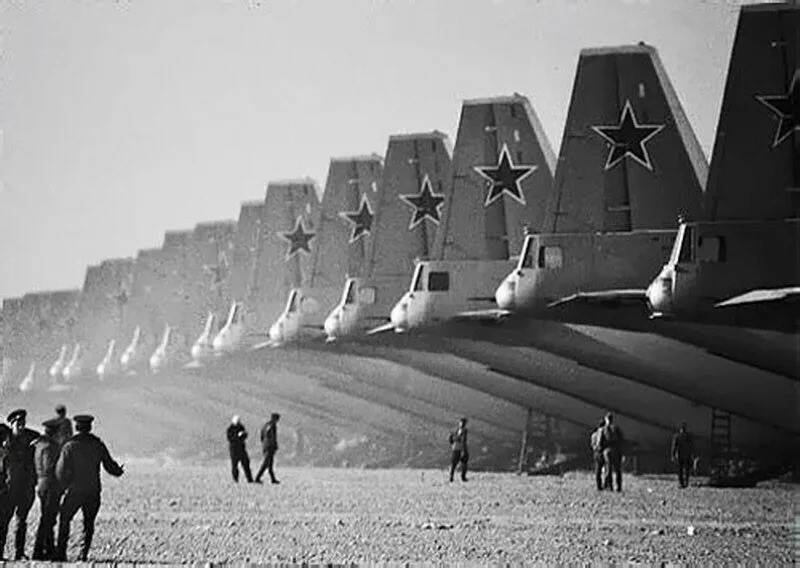
I would pay attention to a few nuances:
– The 2nd battalion of the 317th regiment did not have a full set of military equipment. Instead of 10 infantry fighting vehicles, the companies had 4 (each platoon had a vehicle + the company commander’s vehicle). The airborne support platoon of this battalion transferred its equipment (7 Urals) to other units. Perhaps they were used to raise personnel. The remaining battalions had a full complement of equipment.
– In one of the battalions, the service platoon took with them only field kitchens (3 pieces). The rest of the equipment was left at home. Supplies came directly from regimental reserves. Whether this was a widespread practice is not yet clear.
- The 3rd battalion 357 made calculations for loading based on the flight on the Il-76. And instead of them An-12 arrived. Accordingly, they took as many cars as they could load, and left the rest in Seshche.
The areas of concentration of airborne units and subunits were pre-selected and reconnaissance by officers of the airborne task force, led by deputy commander of the airborne forces, Lieutenant General N. N. Guskov, who arrived in Kabul on December 23, 1979. General Guskov was generally in charge of Afghanistan - he controlled the deployment of the 1st battalion of the 111th regiment, and provided reconnaissance to the command of the 103rd Airborne Division in the fall of 1979. Overall I was a frequent visitor there.
Ahead - Afghanistan
The first to take off was a pair of Il-76 aircraft belonging to the commander of the 339th brigade, lieutenant colonel and his deputy. On the plane were another “supporting” deputy commander of the Airborne Forces for combat training, Lieutenant General V. Kostylev, and a group of officers from the headquarters of the 103rd Airborne Forces, led by the division commander, Colonel Ryabchenko, which included the head of the operational department, the head of the special department, the head of the political department, and colonel , deputy commander for equipment and weapons and other officers.
In addition to people, the division's communications equipment was on board. The second plane was loaded with two command and staff vehicles.
However, the group failed to complete the task within the given time.
The memoirs of the participants explain this as follows:
However, I will express my own opinion.
The main forces were concentrated in Balkhash to capture Bagram. And the planes of the 3rd VTA division with the 357th regiment flew there. And in Kabul, a carousel of 128 VTAP aircraft unfolded. And two “extra” sides would disrupt the transfer schedule. So they were sent home.
Why didn’t these two aircraft go to Bagram?
It is unknown, perhaps the division commander with the Airborne Forces castle wanted to fly to Kabul and only to Kabul. Later there will be an episode when Lieutenant General Kostylev shows himself ugly. As a result, this led to an interesting disposition - the 357th airborne division and all divisional special units - the anti-aircraft division, the engineer battalion and the communications battalion, the medical battalion, the emergency battalion and the transport company ended up in Bagram, and the division commander was without communications in Kabul.
According to the Battle Manual, Part 1 “Regiment, Division” (secret edition), these units primarily ensured the activities of the division headquarters. The sapper battalion equips dugouts and shelters for equipment. The anti-aircraft division (18 ZU-18) first of all covers the division command post, and only then the rear. In a communications battalion, one company provides the work of the division command post, and the other is the command post.
By the way, in one of the interviews, the division’s communications chief stated that some of the communications battalion’s equipment remained in Vitebsk. Forgetting one or two or five portable walkie-talkies is still understandable, but “...given the shortage of communication means, and also the fact that we had no other channels except radio communication, because the rest of the standard equipment - relay stations, hardware ZAS, were located in Vitebsk"…
Why the operation was planned this way is now impossible to find out. They did not forget to load the mobile printing press of the divisional newspaper. The first issue was published on January 1, 1980.
They were noticed in the sky by the commander of the 18th VTAD, who was just leading the 128th VTAP to Kabul. These planes delivered the first echelon of troops to the Kabul airfield - the 2nd battalion with a reconnaissance company of the 350th regiment. The first three vehicles came with personnel, without equipment - 270 people. Behind them came the giant An-22 with the rest of the regiment's forces.
It can be assumed that during the evening of December 25 and the night, about 25–30 Il-76 aircraft of the 128th regiment and about 26–30 An-22 aircraft of the 12th division landed in Kabul. 60 planes in 12 hours, 5 planes per hour, plane every 10 minutes.
On the morning of December 26, the 317th regiment began arriving in Kabul on An-12 aircraft.
Deceased Il-76
During the landing process at 19:33 (Moscow time) an Il-76 crash occurred on 128 VTAP. The plane was seventh in the group, and overall 23rd in terms of aircraft. The glow from the crashed Il-76M. All participants/eyewitnesses in their memoirs or interviews say that a glow was visible in the mountains.
I don’t know how long a plane must burn if it crashes into pieces on a snowy mountain and is immediately covered with snow. Online, participants and eyewitnesses describe the event as follows:
1. “One of our planes crashed during landing on the first day; it was the 23rd in a row. Our battalion’s kitchen and some equipment were there.”
2. “There was a commandant’s platoon of our 350th RPD, about 40 people, and a crew of 11 people. It contained a GAZ-66 fuel tanker and a URAL with ammunition.”
3. “The IL-76 of captain Vitaly Golovchin from our 128th flight collided with a mountain at an altitude of 3 meters during landing. In addition to the seven crew members, there were 000 paratroopers and a TZA-37-7,5A tanker on board.”
4. “A service platoon of our second battalion and an airborne support company, a tanker with 93 gasoline, and two vehicles with ammunition were killed. There was something to explode!
You can also find the names of all the dead paratroopers, but so far no one has said exactly where they are from.
In one source, this is the commandant company of the 350th regiment. But in the OShS PDP there is no commandant company, there was only a commandant platoon.
In another source, this is an airborne support company. But in the RDO there are only car drivers, why do they fly without cars? There is evidence that the plane had 17 field kitchens. This is generally complete nonsense - there are fewer kitchens in the entire shelf. Besides, who will transport them, they need tractors.
The plane was one of the very first to fly. What is the point of already leading the rear of the regiment before the rest of the regiment (1st and 3rd battalions) arrive? Most likely, it was still part of the service platoon of the 2nd battalion (as the commander of 2/350, Major Krotik, says) and part of the soldiers of the commandant’s platoon of the regiment (some soldiers have a military specialty - a traffic controller).
Shpak puts it this way:
At the same time, the following died in the crashed plane:
– Senior Lieutenant M. N. Pugavev. According to Belarusian data, he is the commander of a parachute company. At the same time, in the “Book of Memory of 350 PDP” on the website artofwar.ru, all company commanders are in place, none of them died on December 25.
– Ensign G. M. Bulat. Automobile platoon commander. There is no pure “automatic platoon” in the parachute regiment. In the battalion there is a supply platoon, in the regimental transport and supply company there is a platoon for the supply of materiel, a platoon of airborne vehicles and a supply platoon. Most likely, Warrant Officer Bulat was the commander of the VMO of the 2nd RPD.
– Ensign M. A. Golubev. Company sergeant major. There is no official information about which company. According to indirect evidence - 4th pdr.
Mathematics
Now pure mathematics.
At the end of the 90s, one of the aviation magazines provided the following data:
Since then, this information has been indicated in every book, article or post about the entry of troops into Afghanistan.
All An-22 type vehicles were assembled into the 12th Guards Mginsk Division (8th, 81st and 566th Military Transport Regiments). A total of 65 vehicles were produced, of which by 1979 there were 57 in the division. Most likely, 35–40 vehicles were used to transport 350 PDPs, and about 20 more vehicles from 566 VTAP were used to transport the self-propelled gun division.
The An-12 was the most popular aircraft at that time. It has been in service since the 60s. The 6th and 7th VTAD took part in the Kabul operation, as well as 3 separate regiments: the 194th from Fergana, the 708th from Transcaucasia and the 930th from Zavitinsk. Plus the regiments of 18 VTAD, which have not yet received the Il-76.
A total of 10 An-12 regiments, which could theoretically use 300 vehicles (30 per regiment), but in reality 70-80% of this number (taking into account the technical condition of the equipment), that is, just 200 vehicles. According to some reports, by 1979 there were about 370 aircraft of this type in the BTA regiments. Unfortunately, there is still not a single sensible stories regiments of the 6th and 7th divisions.
During the Zapad-81 exercises, in order to transport 97 airborne troops without one battalion (1 soldiers, 320 pieces of equipment), the entire 72th VTAD (6, 37, 338 VTAP - 363 An-88) needed to be sent out. We can roughly assume that one BTA division on An-12 is enough for one airborne assault squad (12-battalion strength).
The newest IL-76 vehicles began to enter service in 1974. With a production rate of 30 aircraft per year, by 1979 there were 152 aircraft of this type in service. The first to receive cars was 339 Guards. Vtap (Vitebsk) 3rd Guards. vtad. Then the 110th regiment of the same division, then the 128th regiment of the 18th Guards. Vtad, then the 334th regiment again the 3rd VTAD.
Thus, by the beginning of the KabVDO, only 4 regiments were completely re-equipped with new equipment. Another group of units had equipment in homeopathic quantities, plus training centers. But, according to official data, only 77 vehicles took part in the operation (according to others - 50).
It can be assumed that the regiments did not participate in full force, but the participants talk about the full departure of the 3rd division (110, 334, 339 regiments - 70–90 vehicles). The same crashed Il-76 of the 128th regiment was on the 23rd. It turns out that many more IL-76 type vehicles took part in the operation.
The main combat vehicle of the Airborne Forces in 1979 was the BMD-1 airborne combat vehicle, as well as the BTR-D created on its basis. The Gaz-66B transport vehicle was adapted for parachute landing. The landing of D-30 howitzers, mortars, and supplies of military equipment was carried out on P-7 landing platforms. The An-12 aircraft could accommodate either two platforms or two combat vehicles. The Il-76 has three units, the An-22 has four.
In total, in 343 sorties it was possible to transport:
200 x 2 + 66 x 4 + 77 x 3 = 895.
The figure almost exactly coincides with the textbook figure of landing combat vehicles. The nuance is that there are still many non-landing vehicles left in the airborne division - such as the Ural and Zil. Thus, the commander of the 357th PDP describes that they lowered the wheels on the Ural-375 so that they would fit in the An-12. The capacity of the An-12 is generally a big question.
All the books devoted to this car say that two cars fit into this plane (which I took into account in the calculation above). But participants remember loading only one machine. For example, “you can’t load much into the AN-12, one BMD, boxes of ammunition and 10-12 people in the pressurized cabin.”
The crashed Il-76 contained 2 vehicles - a tanker and a Ural with ammunition (but this is not certain). In addition, the self-propelled gun division was armed with 30 ACS-85s, which could hardly fit on the An-12 aircraft, and the An-22 carried only 3 (usually 2 self-propelled guns and one transport vehicle were loaded).
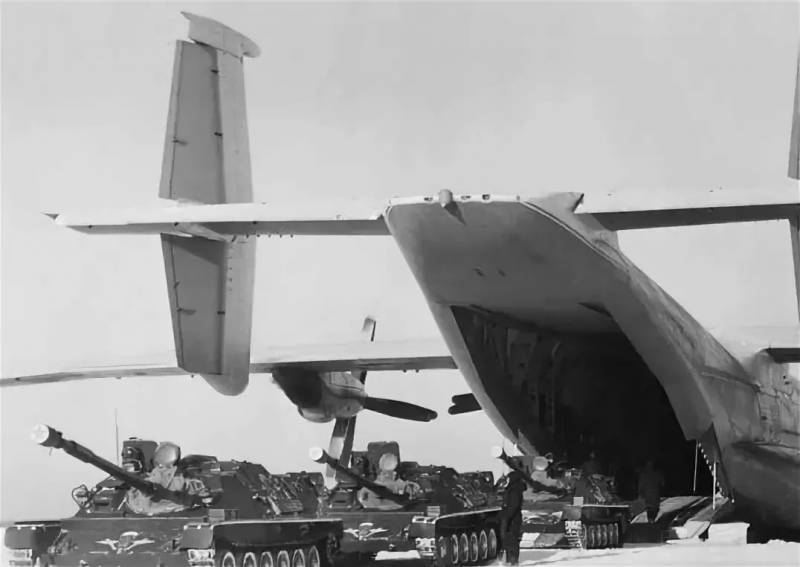
It is now difficult to say how many such equipment there were, but in any case, the canonical figure can be questioned.
Taking into account the above, we get:
200 x 1 + 66 x 3 + 77 x 3 = 629 units of equipment.
And it turns out that there were either fewer vehicles deployed, or more than 343 sorties. If the 128th VTAP immediately flew home, the 3rd VTAD made two more flights from Balkhash to Kabul - the first with the 1st and 2nd battalions of the 357th regiment , the second - with divisional units (sapper battalion, anti-aircraft division, communications battalion and auto company). That is, about 150 Il-76 sorties.
The An-22 aircraft would not have been able to transfer 350 airborne troops and an artillery regiment with self-propelled guns at once. Even based on the official figure of 66 sorties, with 52 aircraft participating, someone had to fly two sorties.
Here is a list of equipment transported by the division in December 1979:
– BMD-1 – 87;
– BTRD – 38;
– Howitzer D-30 – 12;
– TZM tankers – 10;
– SU-85–19;
– GAZ-66 – 124;
– ZIL-131 – 29.
I would assume a minimum of 100 An-22 sorties.
In total, the canonical figure should be expanded to 200 An-12, 150 Il-76 and 100 An-22 sorties.
Total 450.
345 RAP
The thesis has been introduced into historical usage that the 103th separate regiment was deployed together with the 345rd division, but in fact it was already in Bagram. In 1979, the regiment was part of the 105th Guards. Airborne Division and was stationed in Fergana. The situation in neighboring Afghanistan was gradually heating up, and forces were building up accordingly:
– On July 7, the reinforced 1st Infantry Brigade 111th Infantry Division was on the territory of Afghanistan. It would later become the 1st Infantry Battalion, 345th Regiment.
– On December 1, 9 anti-tank missiles and an ATGM battery were transferred to Bagram for reinforcement.
- On the night of December 13-14, the following were delivered: the regiment's control and headquarters, 2 infantry battalions without 6 infantry brigades, a mortar battery, an anti-aircraft battery, a reconnaissance company, an engineer company, a communications company, part of a transport company and other units.
- On the night of December 20, a howitzer artillery battalion was missing 3 guns.
- On the night of December 24–25, the remaining units arrived: 3 infantry battalions without 9 infantry brigade, 6 infantry brigade, 3 gabatr and rear units of the regiment.
Thus, by the morning of December 25, the entire 345th Parachute Regiment was concentrated at the Bagram airfield and could not take part in the Kabul VDO that began on the evening of December 25, since it was already in place and met the 357th Regiment.
True, neither the flying Vitebsk residents nor the guards-paratroopers in Bagram were informed about the upcoming meeting.
This is how Colonel Dvugroshev, head of the air defense of the 103rd Airborne Division, senior in the Bagram group of forces, describes the landing in Bagram:
To everyone’s surprise, a paratrooper from the battalion, a major of the 345th Parachute Regiment, was in this unit, bringing drinking water in a GAZ-66 car.
The airborne battalion... was sent to Afghanistan at the request of the Afghan government... Of course, we were not aware of this.”
Again.
On the evening of December 25, the air bridge begins operation. One after another, roaring Il-76s arrive (mostly An-345s from Fergana were used to transport the 12th regiment), and equipment is being unloaded from them. By the morning of December 26, 357 regiment and divisional units were deployed, at least 200 sorties. AND none from the 345th Regiment did not ask the question: “What is actually happening.” Is this securing a meeting?
In my understanding, “ensuring a meeting” is when soldiers approach each landing plane and say – you should run there, go here or stand here. But in fact, only after a complete landing, by chance (I don’t think they sent an officer on purpose in the most useless vehicle in terms of combat) a meeting of the paratroopers took place.
And here is how the commander of the reconnaissance platoon of the 80th separate divisional reconnaissance company, senior lieutenant Marchenko, describes the landing:
Bolotov and his crew pushed BMD number 188 onto the concrete. The vehicle rolled away from the rolls by inertia, the engine started, and it rushed to cover Safarov’s compartment from the control post and the airfield security barracks.
Nishchenko's squad successfully rolled out combat vehicle number 189. Having started the engine, it positioned itself at the line of covering the aircraft from the anti-aircraft battery. My commander with number 187 rolled out next, and the plane immediately taxied onto the runway. 15 minutes had passed since landing, and Il was already rushing for takeoff. In the command vehicle I drove to the beginning of the runway, illuminated by navigation.
It’s clear that if our Il landed and took off normally, then the runway is clear, but I was worried about another point. The landing and takeoff of the plane were heard and seen by Afghan anti-aircraft gunners and airfield security, so I accepted the possibility that the runway could be blocked by equipment.
There were about five minutes left before the battalion landed. In a combat vehicle I flew to the end of the runway - fine. Almost immediately a rumble was heard: the advance detachment was landing. The first side, turning on the spotlight, touched down on the runway, followed by the second and third ones, and taxied to the unloading site.
The planes, having unloaded equipment and personnel, took off one after another. The advance detachment of the 103rd Guards Airborne Division took control of the Bagram airbase without firing a single shot and was ready to receive the main landing forces.”
Not a word about those who meet and provide from 345 traffic police. Therefore, it is necessary to either expand the time frame of the operation, or take the 345th regiment out of the equation.
On the ground
So the planes land in Kabul and Bagram, and the fighters push their BMDs out of the planes. They just push it out. For example, as the political officer of the 7th PDR 350th Regiment describes it:
Mechanics and operators rushed around their machines. We opened the power compartments and tried to pump them, but it was no use. The temperature of the plane's cargo compartment was not high, and time was short. Kabul was approaching. And then the landing. The ramp goes down.
My car is in first position. I go down the hatch. Everyone surrounded them and shouted: “What should we do?” Push! The ramp lowered, and the plane taxied from the runway without stopping.
Everyone who was free, including the pilots, piled in. The BMD plopped onto the concrete. Having thrown off their cars as they went, the planes left the taxiway for takeoff. The Ural arrived and pulled the dead equipment onto a green field with a cable, making room for the next aircraft.”
General Shpak says:
They thought and thought and came up with an idea: they began to pull back the combat vehicles with Ural vehicles. Special trained teams were prepared. When the plane landed, the Ural pulled the first car to the side, and the mechanic on the ground launched the launcher, when the second car was pulled out by another Ural, the first one was already making room.”
From the evening of December 25 until the morning of December 26, the 350th regiment was transferred to the Kabul airfield. In the morning the 317th regiment began to arrive. On night 27, the transfer of the 1179th Arregiment began.
By the evening of December 27, all assigned units, including the division command, were in Kabul. In Bagram, from the evening of the 25th to the morning of the 26th, the landing of the 357th regiment and special units took place.
As they arrived, the units settled in - they set up tents (those who had them), dug in equipment, and organized defense. Suddenly it turned out that all the insignia had to be removed and the guards insignia on the vehicles had to be painted over. Of the two communication vehicles that arrived with the division commander, one was taken by the Airborne Forces OG. The division commander was left with the only manual landing gear, which bore the entire load in the first days, before the arrival of the equipment from Bagram.
And on the evening of the 27th the war began.
I will not describe the course of events in Kabul - this has been done many times before me. I will give a direct speech from Colonel Dvugroshev, the commander of the group in Bagram, about the events there:
1. "Storm-333" - began combat operations.
2. “Zarevo-555” – went to the object.
3. “Hurricane” – completed the task.
4. “Calm-888” – I complete the task.
5. “Storm-777” - I’m fighting.
6. “Silence-999” – they do not offer resistance.
One of the main tasks was to capture the Bagram airfield without bloodshed at any time. Negotiations, indoctrination, and agitation in the Afghan army continued on December 26–27, 1979. At 16:27 on December XNUMX, it was reported that almost all military units and subunits promised not to march or offer resistance to the Soviet Army.
To strengthen the capture groups of the 345th airborne division, which were supposed to capture the Afghan anti-aircraft division, two anti-aircraft batteries were allocated, armed with anti-aircraft guns (ZU-23) of the 105th separate anti-aircraft artillery division.
On December 27, 1979, at 18:19, all units and capture groups received orders to go to the objects and be ready to block them. At 30 p.m. 333 min. ZASovsky telephone, and Lieutenant General N.N. Guskov transmitted the expected signal “Storm-XNUMX”.
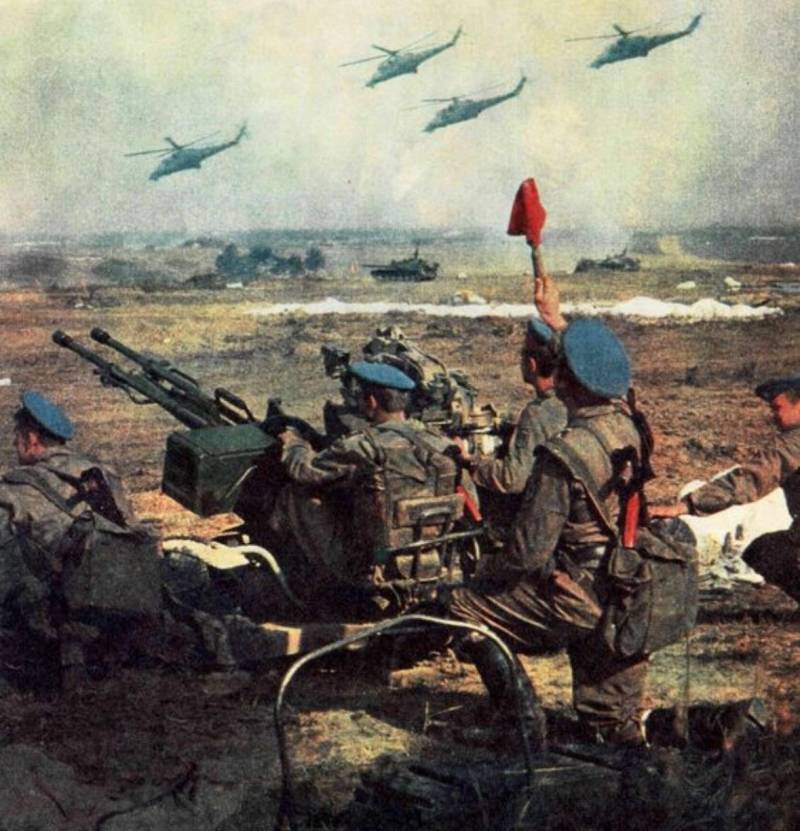
Three people were admitted to the medical battalion, which was deployed to receive and treat the wounded. There were no casualties on our side in Bagram. After completing this task, Lieutenant General Kostylev transmitted the order: “There is only one 345th airborne division left in Bagram. 357th RPD, all special units and 3CP leave for the city of Kabul in thirty minutes. Upon arrival at the site, they will receive tasks.”
I tried to explain to him that I couldn’t leave in thirty minutes, since there was still a firefight going on. I asked permission to leave in an hour. In response I heard harsh abuse and a threat that I would go to trial. I had to make this request to the head of the operation, Lieutenant General N.N. Guskov. After listening to me carefully, he allowed the entire group to leave in an hour. I called all the unit commanders to the command post and began setting tasks.
When leaving Bagram, the convoy was fired at several times by single machine gunners, but there were no casualties. Having completed the march, all troops arrived in the city of Kabul at the airfield 4 hours later (instead of the two planned).

Conclusion
After all these events, the paratroopers expected to be taken home. They completed their task perfectly, the city was taken.
However, the remaining mobilized units of the 40th Army looked very, very weak against the background of the Airborne Forces.
And the 103rd Division had to stay for 10 long years.
Information